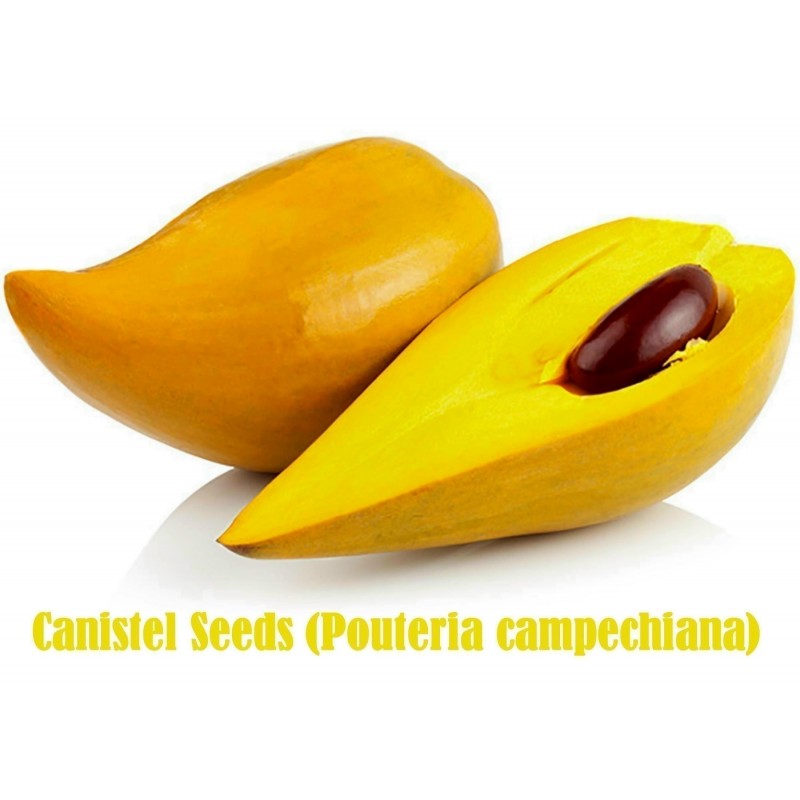










Σπόροι Φρούτα αυγών, Canistel, η κίτρινη Sapote (Pouteria campechiana)
Τιμή για το πακέτο των 1 σπόρους.
The canistel (Pouteria campechiana) is an evergreen tree native to southern Mexico and Central America.[3] It is cultivated in other countries, such as Brazil, Taiwan, Vietnam, Indonesia and the Philippines for its fruit. The canistel grows up to 10 meters (33 ft) high, and
The canistel (Pouteria campechiana) is an evergreen tree native to southern Mexico and Central America.[3] It is cultivated in other countries, such as Brazil, Taiwan, Vietnam, Indonesia and the Philippines for its fruit.
The canistel grows up to 10 meters (33 ft) high, and produces orange-yellow fruit, also called yellow sapote, up to 7 centimeters (2.8 in) long, which are edible raw. Canistel flesh is sweet, with a texture often compared to that of a hard-boiled egg yolk, hence its colloquial name "eggfruit". It is closely related to the Mamey sapote and abiu.
Fruit description
The shape and size of the fruit is highly variable, depending on the cultivar. The better selections consistently produce large ovate fruit with glossy skin weighing upwards of 14 ounces. The flesh is somewhat pasty, although the best varieties have a creamy mousse-like texture. The flavor is rich and is reminiscent of an egg-custard. The fruit may contain between one and six large brown seeds.
The canistel displays climacteric fruit ripening. A fully mature fruit shows an intense yellow skin color. It will eventually soften and drop from the tree. Insects and birds avoid the fruit flesh, perhaps because of its astringent properties, that are much reduced in senescent fruits, but still perceptible to the human palate. Apparently mature fruits severed from the tree while still hard often fail to develop the desired climacteric changes in terms of reduced astringency and a texture reminiscent of egg yolk. This, and the fact that climacteric fruits quickly start to decay at ambient temperatures, may have contributed to the low economic importance of the canistel.
Uses
As the related lucuma, the canistel can be eaten out of hand. The ripe fruit has been made into jam, marmalade, pancakes, and flour.[5] The ripe flesh is blended with milk and other ingredients to make a shake, and pureed it is sometimes added to custards or used in making ice cream.
The wood of the tree is occasionally used in construction where it is available, especially as planks or rafters. In its native range, it has been a source of latex used to adulterate chicle.
Etymology
Its binomial name is derived from the Mexican town of Campeche, where it is native.
In the numerous countries where it is cultivated or sold, it is known by many vernacular names; canistel is common, as are variations on egg-fruit and names referring to its yellow color.[6] In the Philippines it is called chesa or tiessa or tiesa. In Sri Lanka this fruit is known as Laulu, Lavulu or Lawalu.[5] In Thailand it is known by different traditional popular names such as Lamut Khamen (ละมุดเขมร="Khmer Sapodilla") or Tho Khamen (ท้อเขมร="Khmer Peach"), folk imagination attributing a hypothetical Cambodian origin to this fruit (the name of the fruit is See Da in Cambodia).[7] Currently those names are discouraged by linguistic authorities and names making no reference to Cambodia, such as Mon Khai (ม่อนไข่) —Khai meaning "egg", or Tiesa (ทิสซา), are officially favored.[8]
The plant's name in the Vietnamese language is cây trứng gà ("chicken egg" plant) because of the fruit's appearance. It also has the Vietnamese name lekima. This is unusual because Vietnamese is a tonal, isolating language whose morphemes all consist of a single syllable. It appears that this name derives from the word lucuma.[citation needed]
In Indonesian Language it is called alkesah, or sawo mentega (butter sapodilla, for its color and texture).
Though relatively rare in East Africa, they can be found and in the Swahili language, the fruit is confusingly named "Zaituni" which is the same word used to refer to Olives.

 Reviews (0)
Reviews (0)